Henry V, 1944, directed by Laurence Olivier, screenplay by Dallas Bower, Alan Dent, and Laurence Olivier, from the play by William Shakespeare.
It's not surprising that Great Britain produced a propaganda film during World War II in which an absolute ruler uses a flimsy historical pretext to justify an invasion of France. What's surprising that the ruler in question is the hero of the movie, rather than the Hitler surrogate his behavior would suggest. Although adapting Henry V seems to me like a perverse decision if your goal is to boost wartime spirits, Olivier's version of Henry V did this so successfully that it has become inextricably linked with the mythology of World War II. Band of Brothers wasn't about Agincourt.
In fact, adapting Henry V at all seems perverse to me; as Shakespeare goes, it's decidedly second-rate. In part this is because it followed Henry IV parts I and II, both of which feature an as-yet-uncrowned Henry V as a major character. By Henry V, Henry has already undergone all the character development he's going to, climaxing with Hal's rejection of Falstaff. In Henry V, he's nearly all brash self-confidence and action, which is less interesting than, say, Hamlet. The structure of the play is also weak; all the action is over by the end of the fourth act, and the fifth act, which shows Henry's courtship of Katherine, is both dull and unnecessary. The comedic sections of the play aren't very funny; Pistol, Bardolph, and Nym aren't appealing the way Falstaff is. And although Agincourt made Henry V a military hero (armed with longbows, his badly outnumbered men massacred 10,000 French while suffering fewer than 500 casualties), he was by most accounts a terrible ruler. In the play, he launches an unnecessary war, has one of his friends hung for petty theft, and orders the slaughter of unarmed prisoners of war. William Hazlitt quite correctly called him an "amiable monster." So how did Olivier make him a hero?
For one thing, he and Alan Dent purged the play of anything that complicates Henry's appeal. In the film version, Henry's domestic woes with the Scots are left out, as is the treachery of Cambridge, Scroop, and Grey. Olivier's Henry never slaughters his prisoners or hangs Bardolph. One gets the impression that if Henry's rejection of Falstaff weren't so central to the Henry IV plays, Olivier would have left it out as well. All this sounds like the movie isn't any good; it's one of Shakespeare's least interesting protagonists, minus what little complexity he has. (I'm referring here only to Henry V as he appears in Henry V—Hal in the Henry IV plays is a different matter). However, like many film adaptations of minor Shakespeare plays (see, for instance, Julie Taymor's Titus), Henry V has formal qualities that are interesting independently of the play on which it is based.
The big question with any Shakespeare film is how you're going to stage it. The tragedies seem to be most open to interpretation in this way (and, not coincidentally, they have the most archetypal characters). For an easy example, look at the three versions of Hamlet in the last fifteen years. Zeffirelli medieval staging, Branagh's 19th century version, and Almereyda's contemporary New York. With the history plays, I think most directors feel more bound by the fact that they're depicting actual figures from English history; Richard Loncraine's Richard III is the only dramatic restaging of one of the histories I can think of. Olivier doesn't abandon historical reality as dramatically as Loncraine does, but he does something I've never seen in a Shakespeare film before: rather than decide on one way of staging the film and sticking with it, he has three different settings and production designs, and moves from one to the other as the play progresses.
The movie opens by depicting a performance of Henry V at the Globe in 1600 (which was, at the time, the conventional date given for its first performances). Olivier chooses this setting advisedly; first, this staging immediately deflates some of the pomp and circumstance that audiences may be expecting with a Shakespeare play. Rather than seeing Henry for the first time as Shakespeare wrote him, entering surrounded by lords and attendants, Olivier shows us the actor who plays him clearing his throat as he prepares to go onstage.
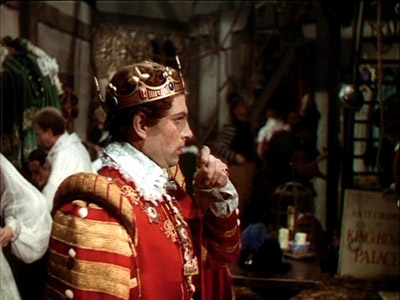
Lawrence Olivier looks nothing like the Burger King here. You uncultured brute.
In fact, Henry's first speech is seen from the backstage area; note the audience in this shot. The shots of the audience provide the equivalent of a laugh track, coaching the audience on how to react through the first act of the play.

This audience reaction is actually critically important to Olivier, because the first act doesn't exactly make Henry out to be a hero. The Archbishop of Canterbury and the Bishop of Ely, worried that Henry will pass a bill that would impose great taxes on the church, convince him that he has a legal right to the crown of France, and send him on an elective war to claim it, thus distracting him from domestic issues. You don't get that impression from the movie, however, because Robert Helpmann's Bishop of Ely is a buffoon, and the entire discussion of succession is papered with physical comedy from Helpmann and laughter from the groundlings. I'm not really sure how one could successfully stage the Archbishop's speech in this section without it being deathly dull, but I do think that Olivier's solution has the added benefit of glossing over Henry's reasons for going to war. There are no distractions like Helpmann during the tennis ball scene, where Henry gives his first stirring martial speech. Unlike the church's machinations, of course, the tennis balls are Shakespeare's invention, and they make Henry seem more justified than he was. (If you haven't read the play recently, the French Dauphin sends a gift of tennis balls to Henry in lieu of the throne, suggesting that his time would be better spent at tennis than at statecraft).
So far, so good; the movie settles into a nice flow between onstage and backstage action (though no dialogue is spoken backstage). Once Henry reaches Southhampton and prepares to set sail to France, however, Olivier enters a new section of the film. He imitates medieval illuminated manuscripts, with their flat staging, bright colors, and lack of perspective. It's really a bold move to make in a pre-CGI world, and I was impressed with how well he pulled it off. Because the staging in the early sections of the film is deliberately cheesy (as one might expect in a theatrical production circa 1600), and because the sets in this section are incredibly artificial-looking, it's easy to miss how carefully and deliberately they have been designed. Here are three examples:
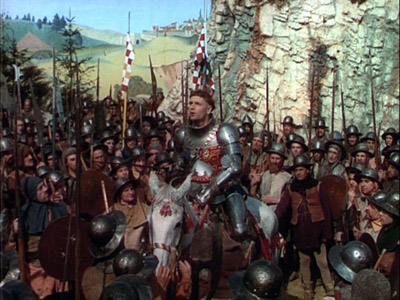
Compare this to any medieval depiction of an army you choose. Notice how the slight downward angle of the camera simulates the pre-perspective medieval convention of using height to indicate depth.
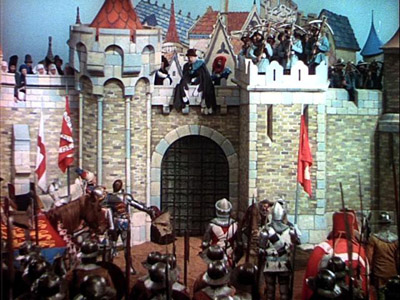
Again, height equals depth—and notice the archers in the right-hand tower, artificially posed as they might be in art of the time.
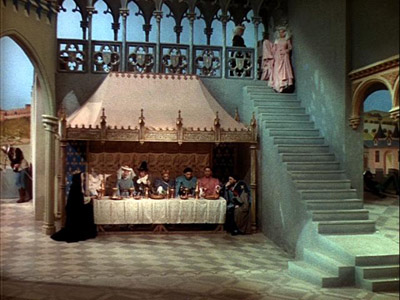
This is part of the French court; no one in their right minds would lay out a room this way.
The third section of the film begins at Agincourt and is staged realistically. Here's the first shot:
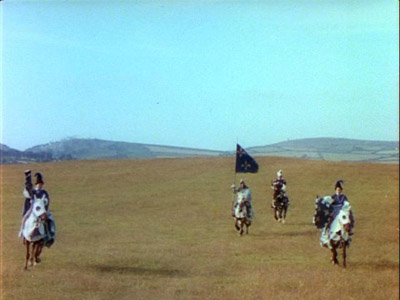
Mountjoy and his attendants ride their horses right at the camera, hitting viewers over the head with the fact that the third dimension has now returned. This act was my favorite; Olivier's Eisenstein-inspired depiction of Agincourt is the most exciting and accessible portion of the film by a lot. The French Cavalry's charge is really excellent filmmaking, including a showstopping 1/2 mile long tracking shot. Here's the beginning of it:
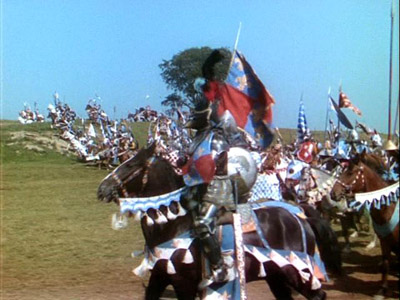
The camera stays on the knight in the center of the frame as the entire line of horses slowly accelerate from a walk to a full-on gallop. The shot lasts just under a minute, and the sense of tension and speed it gives you is incredible. It's followed by Henry's archers letting their first volley fly. Apparently this shot is lifted from Alexander Nevsky, but it's been in hundreds of movies since then, from Gladiator to Lord of the Rings:
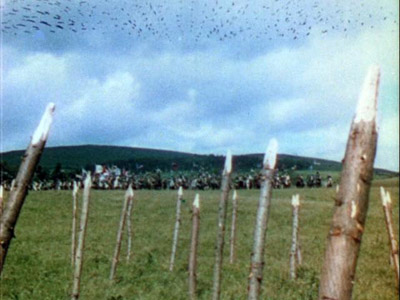
Arrows go up...
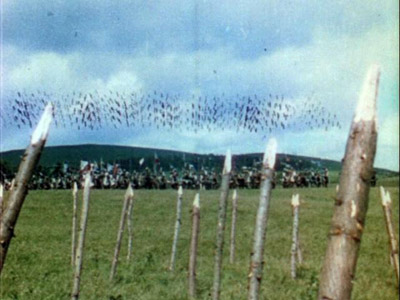
Arrows go down. You'll have to imagine the sound effect of hundreds of arrows whistling through the air, but it's there.
This section is pure bravura filmmaking, and it has aged much better than the rest of the movie. Following the open fields at Agincourt, Olivier brings the film back to the illuminated manuscript sections, and finishes the movie as it began, at the Globe theater. The symmetrical layering of production design feels a little like an undergraduate computer science lecture on recursion; I can't think of another film with this kind of structure, much less a Shakespeare adaptation.
Interesting structure can make a film a curiosity, but it's not enough to make it worth seeing. To me, except for the Agincourt section, the movie simply wasn't very compelling. In part, my feelings here are predictable; as you've probably noticed, Henry V isn't my favorite Shakespeare play. And my experience watching Olivier deliver the St. Crispin's Day speech (which he knocks out of the park) is obviously different than it would have been for a Brit in 1944. But the vast majority of the movie is very theatrical, and I found it hard to get past the stylized production design and into a point where I cared about any of the characters. That sounds like the whine of a bad filmgoer or studio executive ("the characters aren't relatable!") but I think it's a fair criticism. Shakespeare more than any other writer is renowned because his characters have resonated with viewers for hundreds of years. Henry V doesn't really accomplish that.
Randoms:
- Henry V was probably the first movie to be developed from a television project. Dallas Bower, one of the producers, had worked with Olivier on a BBC program called "Scenes from Shakespeare," which was broadcast in the late thirties, at a time when there were perhaps 500 television sets in England. So the next time you're sitting down to rewatch Starsky and Hutch or The Dukes of Hazzard, give a little tip of the hat to the filmmakers who made it all possible.
- The production design during the medieval painting sections of the film was inspired by Les Très Riches Heurs du Duc de Berry, a book of hours that was unfortunately in occupied France when the film was made. So the art department was working from magazine reproductions of the calendar section of the book. The costumes draw from the book throughout, but the most blatant quotation is the shot that opens Act V. Here's the illustration for February from the book:

- and here's the opening shot from Act V.
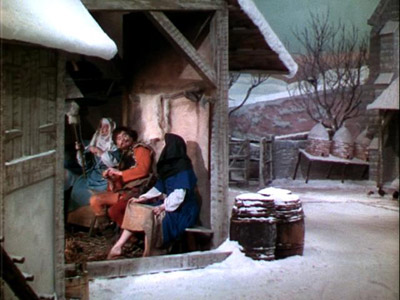
- That's Robert Newton in red, looking considerably less menacing as Pistol than he did as Bill Sykes in from David Lean's Oliver Twist.
- You might be wondering how Olivier pulled off battle scenes with hundreds of able-bodied men running around on camera in the middle of World War II. He did it by shooting in Ireland, which was neutral during the war, using Irish soldiers as his extras. This had the added advantage of making it less likely he'd have to stop a shot because a German bomber flew in-frame.
- You've probably noticed from the stills the oversaturated Technicolor look the film has. Although most of the movie uses the kind of brightly lit sets that Technicolor representatives recommended, the scenes in 4.1 are quite dramatically underlit. Here's an example:
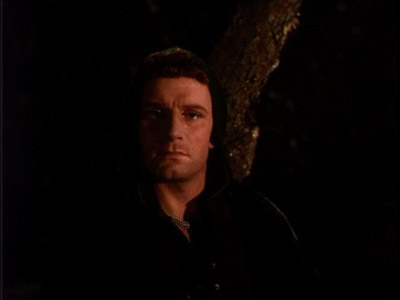
- Gordon Willis was presumably taking notes. Incidentally, the Criterion edition was transferred to DVD using the YCM protection masters. This is an archival format related to the three strips of Technicolor Process 4. If you don't know how Technicolor worked, check this article out. Anyway, in Technicolor Process 4, your end product is three exposed black-and-white negatives, one for Yellow, one for Cyan, and one for Magenta. These are better for archival purposes than a color print (or an Eastman one-strip color negative) because black and white film ages better. In a YCM master, the three strips are combined into one black and white print with consecutive frames from each print; you get a frame from the yellow print, then the cyan, then magenta. Why combine the strips into one master instead of storing them separately? If anything causes the film to shrink, warp, or fade, this will affect all colors equally.
- Filippo Del Giudice, another of the film's producers, spent the last five years of his life in a monastery. If only this option had been available to Don Simpson!


2 comments:
If further justification for the inclusion of Armageddon in the Criterion collection is needed, please note the forty two comments and replies your essay on that film engendered as compared to zero comments for Henry V . But for the first time ever I am the first to post a comment.
The assessment of Henry V as second-rate Shakespeare may or may not be off the mark. That all depends on what we’re talking about. I’ve read it several times, and I think many passages achieve greatness. I’ve also seen both film versions, and I think Henry V serves as a great screenplay: its many short scenes (some only a page long), its quick leaps between England and France and back again, the several small vignettes as Henry meanders through his camp the night before Agincourt are all innately cinematic. Plus, there’s the Battle of Agincourt, which is pure cinema. Henry V may not, however, be a great theatrical experience.
I’ve never seen Henry V staged, but I suspect it would be a disappointment. The problem isn’t that the climax occurs in Act IV, but that the play doesn’t have a true climax at all. It depicts the reasons for, the preparations for, and the aftermath of a great battle while neglecting the battle itself. This is a limitation of the stage. But film Henry V and you can deliver the climax it never has on stage.
The comedic scenes are not particularly funny. In the Branagh version these scenes aren’t played for laughs and as a result play more successfully. Similarly, in the Olivier version the King of France (first seen sitting on the floor) and his dauphin are played respectively as a buffoon and an ineffectual fop. While this is understandable given the production’s raison d’etre as a glorification of wartime Britain, I think overall that by cheapening the adversary you cheapen the victory. Branagh on the other hand casts Paul Scofield, always imposing, as the French monarch. Finally, in the way the text was edited, we are presented with a more complex title character in the 1989 film. Olivier consistently hits a single, bland, saintly note throughout his performance.
In almost every way the Branagh version is a far more exhilarating experience than the impeccably crafted but overly stately and antiseptic Olivier production. The exception is the battle of Agincourt, where both films rise equally to the occasion. Olivier’s staging of Henry V, both clever and beautiful, also mimics the experience of seeing a successful play, where obvious artifice slowly fades as you are drawn into the world of the play. And there is a sweet quality to the short fifth act denouement depicting Henry’s courtship of Katherine that to some may seem irreconcilable with the remainder of the film. But to me much of its charm lies in that contrast.
You guys need to read Andre Bazin on this movie. Then you would begin to understand it better, I think.
Post a Comment